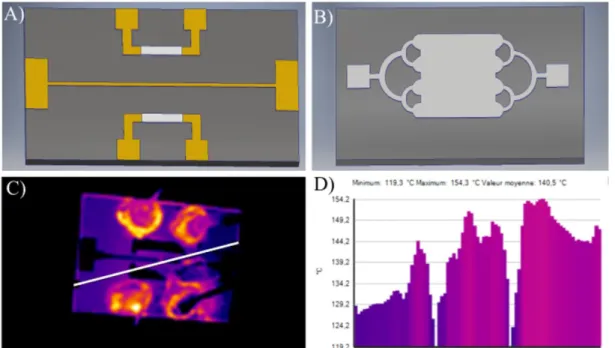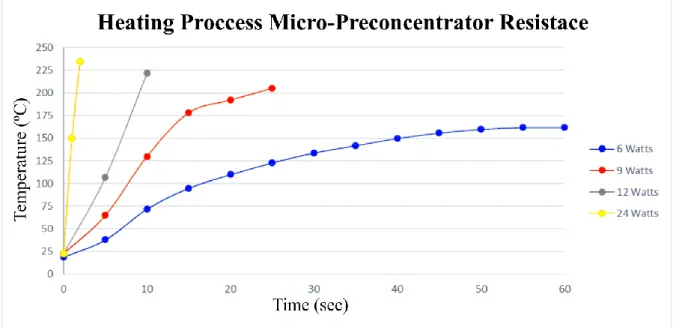Proceedings of the 3rd MIGRATE Workshop June 27-29, 2018 – Bastia, France
1 A Marie-Curie-ITN
within H2020
MIGRATE2018:210644
INCREASING THE SENSITIVITY OF A BTEX ANALYZER BY
INTEGRATING A PRECONCENTRATOR – PROOF-OF-CONCEPT.
Alberto Rodríguez-Cuevas*
1, Irene Lara-Ibeas
2, Christina Andrikopoulou
2, Stéphane Le
Calvé
1,21 In’Air Solutions, 1 rue Blessig, 67000 Strasbourg, France. senglaro@inairsolutions.fr 2 University of Strasbourg, Institute of Chemistry and Processes for Energy, Environment and Health
(ICPEES), Group of Atmospheric Physical Chemistry, Strasbourg France. slecalve@unistra.fr
*
corresponding author:
arodriguez@inairsolutions.com
KEY WORDS
Preconcentrator, microfluidics, MEMS, portable analyzer, BTEX, air quality
ABSTRACT
Introduction
Indoor air pollution is identified as an important health hazard worldwide. Among various indoor air pollutants, BTEX compounds (benzene, toluene, ethylbenzene and xylenes) are known to be harmful to human health even at low levels. Especially benzene which is classified as carcinogenic to humans by the International Agency for Research on Cancer (IARC). In this context, the French government has established a threshold of 5 µg m-3 (1.6 ppb) for benzene in indoor air of public buildings, which is expected to be decreased in the near
future down to 0.6 ppb. [1,2].
ICPEES and In’Air Solutions have recently developed a portable miniaturized GC for in situ and real time detection of BTEX at ppb levels [3,4]. Some of the state-of-the-art characteristics of this analyzer are a time resolution of approximately 10 minutes, a gas consumption of 3ml/min, and a high sensitivity (few ppbs for benzene). However, given the expected threshold value of 0.6 ppb for benzene the GC analyzer needs to be improved. The integration of a preconcentrator system inside the current analyzer could be a suitable response to solve this issue.
A gas or vapor preconcentrator is an analytical device that significantly improves the detection limit of a microanalytical system first by preconcentrating an analyte over a given period of time and afterwards by injecting it into the column and subsequent detector through a heat pulse that induces a flash desorption [5]. Besides, a preconcentrator demands a steep temperature increase in the order of 150 °C in a very short period of time (few seconds). As a result in commercial instruments, either the energy consumption of the preconcentration system is very high or the time needed for the adsorption-desorption cycle is too long. Thus, the preconcentrator would not be in agreement with the requirements of a portable, autonomous and near-real-time analyzer. Microfabricated based preconcentrator (micro-preconcentrator) with significantly reduced dimensions and integrated heating elements could provide a solution to these drawbacks. In order to validate this conception, two different approaches have been followed. On the one hand, preconcentration tests of adsorption-desorption have been performed by using a macro-preconcentrator. On the other hand, a
Proceedings of the 3rd MIGRATE Workshop June 27-29, 2018 – Bastia, France
2 A Marie-Curie-ITN
within H2020
microfabricated heating system has been tested to be integrated in the future micro-preconcentrator. Together, both approaches would validate the proof-of-concept of the whole micro-preconcentrator for our particular purpose.
Preconcentration test
An aluminum macro-preconcentrator with dimensions of 40 mm × 40 mm × 12.3 mm and a total weight of 54,89 gwas designed and fabricated following some basic principles and characteristics found in the literature (See figure 1 b). It was filled with 2 mg of Carbopack B (Matrix Carbopack B, 60-80 mesh, SUPELCO). This adsorbent was conditioned using of 20 ml/min of pure nitrogen for 1 hour at 240ºC.
During the experiments, blanks and tests were performed using the same conditions: a flow rate of 5mL/min and a sampling time of 8 minutes, providing a total volume of injection of 40 mL. Blank injections were performed with pure N2, while BTEX were injected at a concentration of 100 ppb for every compound, i.e.
benzene, toluene, ethylbenzene, and orto- para- and meta-xylene. The experimental setup employed is described in Fig. 1. Once the 40 mL passed through the preconcentrator, the second six-port valve switched and the device was heated up to 200ºC in 1 min and 10 seconds and maintained at this temperature for other 10 seconds. This heating process favors the fast desorption of the adsorbed components. Once the 6 port-valve was switched on, the carrier gas passed through the preconcentrator to carry the desorbed compounds toward the capillary column (RXi-624, 20 m long, 0.18 mm i.d., 1 µm film thickness, Perkin Elmer) where the BTEX were separated. Finally, the detection was ensured by a photoionization detector (PID) (piD-TECH® eVx Blue, Baseline Mocon, CO, USA) which provides a signal proportional to the concentration of the target compounds in the sample.
Figure 1: Schematic representation of the laboratory prototype of the BTEX analyzer with a preconcentration stage.
Blue arrows: Air sample with BTEX compounds; green arrows: pure N2.
The results of an injection and preconcentration of 40 mL of 100ppb as previously described are presented in the Figure 2A, while Figure 2B represents a direct injection of 200 µl of 100 ppb (BTEX diluted in N2).
In the case of the direct injection, the peak areas were 10109 units for benzene, 4625 units for toluene, 4223 units for the other 4 compounds, while after preconcentration the peak areas were 330803 units, 223459 units, 59416 units, for benzene, toluene and the rest of the compounds respectively. The size of the area is directly proportional to the concentration. Therefore, the definition of the preconcentrator factor, Pf, is given in Eq.(1):
where A1 is the peak area after the preconcentrator and A2 is the peak area for the direct injection. Thereby, the preconcentration factors were calculated to be 40.42, 42.9, and 63.42, for benzene, toluene and the rest of the compounds respectively. This proves that the addition of the preconcentration unit improves significantly the sensitivity and reduces the detection limit of the device.
𝑃𝑓 =𝐴1
Proceedings of the 3rd MIGRATE Workshop June 27-29, 2018 – Bastia, France
3 A Marie-Curie-ITN
within H2020
Figure 2: A) Chromatogram related to the injection of BTEX after preconcentration of 40 mL of BTEX mixture (100 ppb); B) Chromatogram of the direct injection of 200 µl of BTEX mixture (100 ppb).
Taking into consideration that the adsorption/desorption process is the same for a specific adsorbent and analyte, it is reasonable to assume that the same preconcentrator factors will be obtained when using the micro-preconcentrator. Since it is based on MEMS technology with a very similar microfluidic flow pattern than the macro preconcentrator and the mass is reduced from 60 grams down to 1-2 grams to ensure a fast heating and then a flash desorption.
Heating test
When it comes to energy consumption, the macro-preconcentrator version requires high energy supply, 3 cartridges of 70 watts each one. Therefore, it does not fulfill the requirements for an autonomous portable analyzer. To solve this major drawback a second preconcentrator version (micro-preconcentrator) has been proposed based on MEMS technology (see Fig. 3B). This version has two microfabricated resistances of 43 Ω integrated in the back side of the micro-preconcentrator with dimensions of 15 mm × 25 mm × 1.5 mm. These resistances, (Fig 3A), were fabricated by metal deposition of titanium and gold using e-beam and Joule effect evaporation, respectively.
Figure 3: A) 3D design of the integrated MEMS heating system. B) 3D design of the preconcentrator microfluidic chip.
C) Temperature distribution of the silicon wafer at 200°C. D) Temperature distribution along the white line of figure C. As mentioned previously, the macro-preconcentrator used for this test requires a total power of 210 watts to reach a desorption temperature of 200ºC in 1 min and 10 seconds. This power requirements are mainly due to its weight of 60 grams. Unlike the macro-preconcentrator, the micro-preconcentrator requires between 6 and 24 watts for reaching the same temperature in the same or even shorter time. In Fig. 4, the results of the increase
Proceedings of the 3rd MIGRATE Workshop June 27-29, 2018 – Bastia, France
4 A Marie-Curie-ITN
within H2020
of the temperature in the micro-preconcentrator using different power supplied are presented. Power supplies over 12 watts guarantee a flash desorption since the system gets to 200ºC in less than 10 seconds, which is considerably less time than the 70 seconds required by the previous macro-preconcentrator version.
Figure 4: Temperature increase of the micro-preconcentration prototype at 6, 9, 12 and 24 watts. Conclusions
In this work a micro-preconcentrator conception has been validated. A preconcentration factor of 40 for benzene and even higher for the other BTEX compounds has being achieved by using 2 mg Carbopack B as an adsorbent in a macro-preconcentrator heated up to 200°C. However, preconcentration process should be optimized by increasing the heating rate which will lead to an increase of the preconcentrator factor.
In the case of the micro-preconcentrator, due to reduction of weight, the power required for rising the temperature up to 200ºC is sharply reduced. From an applicability point of view, this fact means that the micro preconcentrator could be implemented within the current BTEX analyzer, thus providing the required sensitivity to respond to new threshold limits of the public authorities. In future work a fully operational version of a micro-preconcentrator will be filled with Carbopack B and its operative conditions will be optimized. Acknowledgements
This ITN Research Project is supported by European Community H2020 Framework under the Grant Agreement No. 643095 (H2020-MSCA-INT-2014).
References and Citations
[1] K. R. Smith et al. (2014). Millions Dead: How Do We Know and What Does It Mean? Methods Used in the Comparative Risk Assessment of Household Air Pollution. Annu. Rev. Public Health, 35, 185-206 [2] Arif A. A. & Shah S. M. (2007) « Association between personal exposure to volatile organic compounds and asthma among US adult population », Int. Arch. Occup. Environ. Health, 80, 711-719.
[3] Nasreddine R., Person V., Serra C. A., & Le Calvé S. (2015) Development of a novel portable miniaturized GC for near real-time low level detection of BTEX. Sens. Actuators B Chem., 224, 159-169. [4] Nasreddine R., Person V., Serra C. A., Schoemaecker C., & Le Calvé S. (2015) Portable novel micro-device for BTEX real-time monitoring: Assessment during a field campaign in a low consumption energy junior high school classroom. Atmos. Environ., 126, 211-217.
[5] Ioana Voiculescu, Mona Zaghloul, Nachchinarkkinian Narasimhan, Microfabricated chemical preconcentrators for gas-phase microanalytical detection systems, TrAC Trends in Analytical Chemistry, Volume 27, Issue 4, 2008, Pages 327-343, ISSN 0165-9936, https://doi.org/10.1016/j.trac.2008.01.016.


